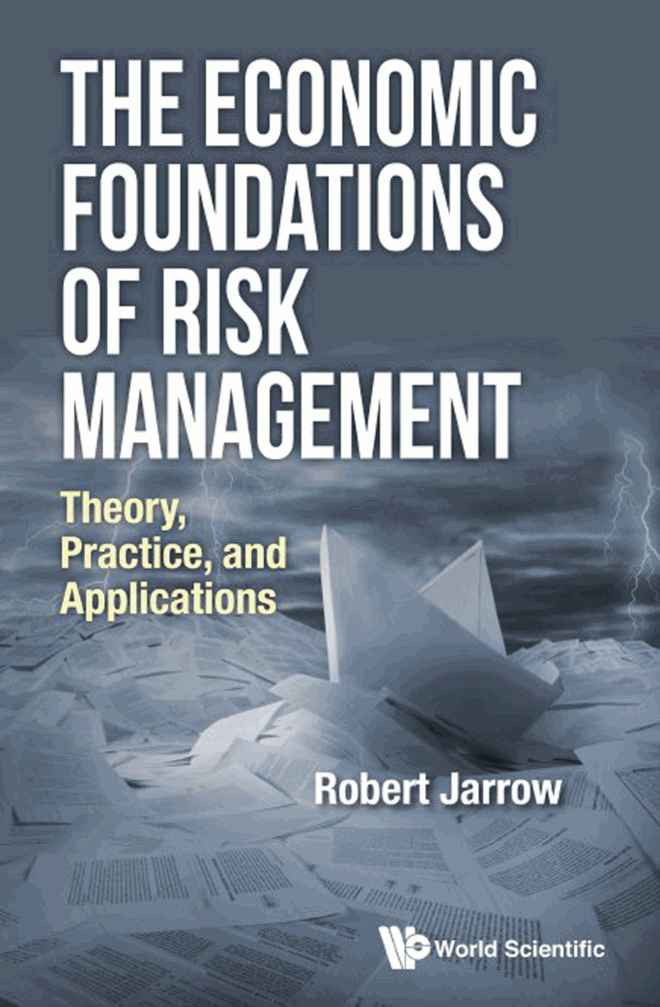
If there is such a thing as a rigorous crash-course on risk management, then this is it! On less than 200 pages, Robert Jarrow provides an economic perspective on financial risk management, preparing future risk managers and regulators in their capacity as decision-makers. Having said that, the book should not be kept a secret from the quant finance community: it is an ideal complement to existing monographs on financial risk management.
The main focus lies in a conceptual understanding of risk management theory and practice from an economic perspective—taking into account how markets function and how risks of different types, such as market risk, credit risk, and liquidity risk can be managed within the constraints of financial markets and financial regulation. Asset price bubbles—very real, but omitted in many financial models mainly due to strong market assumptions—are embedded into the theory.
The text consists of an introductory part (i) and five further parts on (ii) financial instruments, where basic knowledge of both primary assets and derivatives is established; (iii) modelling risks, treating market risk, credit risk, liquidity risk and operational risk; (iv) risk optimisation from the point of view of individuals, firms and financial institutions; (v) managing risks, i.e., risk diversification and hedging; and (vi) seven detailed case studies on Penn Square Bank, LTCM, Orange County, Barings Bank, Metallgesellschaft, Washington Mutual and the credit crisis.
The book’s focus on economics becomes apparent when realising that risk measurement is barely present in the text, and calculation techniques of risk measures are excluded overall. For example, standard risk measures such as value-at-risk are touched upon only briefly in the context of a bank’s regulatory constraint when optimising its shareholder value. As such, the book brings in an interesting different perspective on risk management.
The economic focus also highlights that typical readers of the book will not, in general, be risk modellers, but decision-makers. Vice versa, those who are decision-makers in the need of a brisk introduction to risk management will find this the ideal resource. Nonetheless, although no prior knowledge is assumed, the reader will benefit from a standard background in no-arbitrage pricing. Concepts such as risk-neutral valuation are only briefly explained without the depth necessary to fully embrace the underlying theory.
The case studies, making up about one-third of the book, carefully explain the different types of risk exposures in each case and how unidentified risks or wrong assumptions led to large losses. Treating a fairly large number of case studies benefits the reader in understanding the differences and similarities in quite different situations and scenarios. It becomes apparent, though, that if something was to be added to the book, it should be more detail on risk measurement and its practice. Some of the problems in the cases could have been avoided through minimal risk measurement, even if not sophisticated. For example, a simple value-at-risk limit could have helped avoid the large losses encountered in the Orange County case.
Overall, for the typically quantitative-oriented reader, the book is an ideal complement to texts on risk modelling. Risk types and risk management principles are presented in a terse, no-fuss manner. In addition, plenty of pointers to additional literature allow the interested reader to go deeper into any of the topics presented.
Additional information
Notes on contributors
Natalie Packham
Natalie Packham is Professor of Mathematics and Statistics at Berlin School of Economics of Law and Associated Researcher with the International Research Training Group Non-Stationary High-Dimensional Time Series at Humboldt University Berlin. Prior to that she was appointed Assistant Professor of Quantitative Finance at Frankfurt School of Finance & Management. Natalie spent several years in the finance industry, where she developed trading software for an investment bank. Her main research interests are Mathematical Finance, Quantitative Risk Management and Computational Finance.
